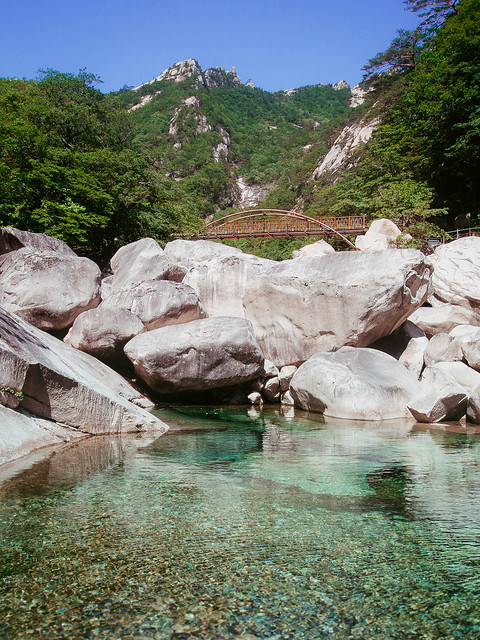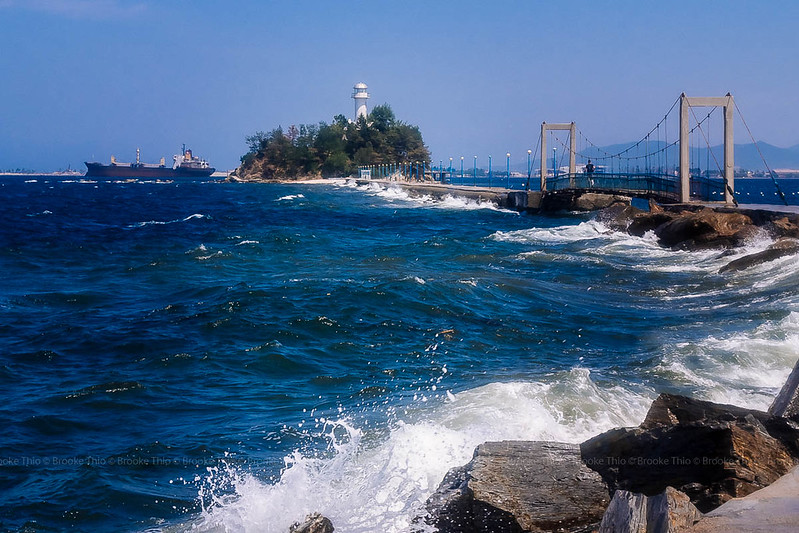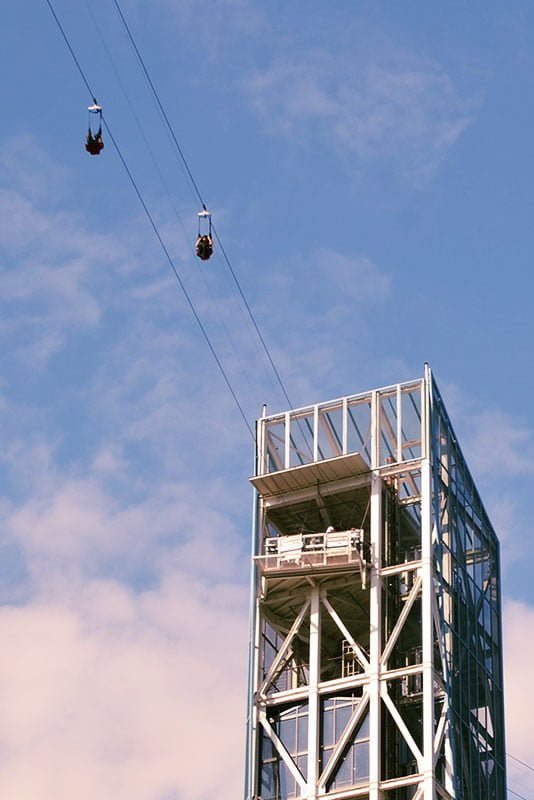Just a quick hop from Seoul, Gangwon-do (Gangwon Province) is one of the most beautiful and thrilling regions in Korea.
Gangwon-do has a fascinating history. It’s the northernmost province of South Korea, bordered by the DMZ and the North Korean province known as…Kangwon-do. Yes, both provinces have the same Korean name (강원도) and used to be a single province before the division of Korea in 1945.
Today, the South Korean side is officially known as “Gangwon State”, but that basically means it’s a special self-governing province. In Korean, it’s still referred to as Gangwon-do.
With the Taebaek mountains cutting along the eastern coast, Gangwon’s inhospitable terrain has made it one of South Korea’s least developed regions, even though it’s the largest province. Past the rocky range, however, waits the blue and bountiful Sea of Japan/East Sea. You know what this means: highland scenery, wild havens, and splendid coastlines for those who love nature and the outdoors.
+ Get the Gangwon-do Google Map with all map points saved!
Things to do in Gangwon-do
Given the vastness of the province and the limited transport options available in Gangwon, I’ve included the county/city for each recommendation as well as directions for getting there. Check out the map for a better idea of where everything’s located.
Chuncheon: Visit Namiseom (Nami Island)
Namiseom is a small half-moon shaped isle, known for its romantic setting: you’ll find walking paths lined with colorful metasequoia, ginkgo, cherry, birch and more. A day tour from Seoul to Nami Island will provide you with plenty of Instagram photo ops.
As a nature and creative retreat, Nami Island is home to a handicraft studio and “learning center” where you can also try making paper and dyeing textiles using natural materials. But where’s the adventure in this, you ask?
It’s when you get to Namiseom – by riding the 80-meter-high Nami Skyline Zipwire from Gapyeong Wharf!
Getting to Namiseom: Book a shuttle bus departing from various locations in Seoul. Alternatively, take the Seoul Metro Gyeongchun Line to Gapyeong station. You’ll find signage for a shuttle bus to Gapyeong Wharf, where you can zipline (KRW 44,000) or ride a ferry (KRW 13,000) to Nami Island.
Got questions on Seoul’s public transport? Get all the answers here.
Cheorwon: Venture into the fringes of the Korean Demilitarized Zone (DMZ)
Gangwon-do was literally split into two in the aftermath of the Korean War, which means it shares its entire northern border with North Korea – and it’s completely off-limits thanks to the Korean Demilitarized Zone (DMZ), which ironically is the most heavily militarized border in the world. As a result, you’ll find several DMZ attractions in Gangwon that are less crowded than the Joint Security Area.
If you’re planning a Gangwon DMZ tour, some of the best landmarks to visit include the Cheorwon Peace Observatory, Korean Workers’ Party Headquarters, the Second and Fourth Infiltration Tunnels, and Goseong Unification Observatory. There used to be a special DMZ Peace Train developed for sightseeing, but unfortunately it has been suspended indefinitely since 2019.
To protect civilians, the South Korean government also established the Civilian Control Zone (CCZ), a buffer zone between the actual DMZ and civilian areas, and the isolation of this area has turned it into a thriving nature reserve. What truly struck me was that people do still live here, tending to their rice paddies which purportedly produce the best rice in Korea.

Before, you’d be able to take the DMZ Peace Train all the way to Baengmagoji Station, the northernmost functioning rail station in South Korea, and join the tour from there for KRW 18,000 (this blogger shared his experience in detail and even spotted endangered red-crowned cranes!)
Getting to Cheorwon: Due to rail line upgrades, it’s best to enroll for the tour in person at Seoul Station (KRW 45,000, train+tour).
Inje: Hike the stunning Taebaek mountains
82% of Gangwon-do is mountainous terrain, so it should come as no surprise that Gangwon province is where you’ll find popular hiking spots like Seoraksan National Park. Hiking Seoraksan in autumn might just be your most rewarding experience as you immerse yourself in magical fall foliage.
If you prefer a more leisurely experience, this Seoraksan day tour from Seoul gives you the option of a quick day hike or a cable car ride up Seoraksan and also includes a visit to Naksansa temple.

Odaesan National Park is closer to Gangneung, and while it features some spectacular views in autumn, it’s better known as a holy site in Korean Buddhism; the main temple here, Woljeongsa, is a head temple of the prevailing Jogye Order.
Getting to Seoraksan or Odaesan: For Seoraksan, take bus #7 or 7-1 from Sokcho Express/Intercity Bus Terminal and alight at Sogongwon. For Odaesan, take the KTX to Jinbu station. From nearby Jinbu Bus Terminal, take a local bus bound for Woljeongsa Temple or Sangwonsa Temple.
Inje: Get extreme with rafting, bunjee jumping, and paragliding
While high-adrenaline activities are available throughout Gangwon-do, Inje County offers the best of them. River rafting and kayaking? Go to Naerincheon. Via ferrata on a cliff above a river? That’s Maebawi Rock for you. Bungee jumping and paintballing are also on the menu.
Getting to Inje: Unfortunately most tour operators offering these sports have Korean-only websites, with the exception of XGAME Resort.

Pyeongchang: Go skiing or snowboarding in winter
PyeongChang county is home to the best ski resorts in South Korea, with the much-lauded 2018 Winter Olympics held here. Ski enthusiasts should head to YongPyong Resort with its 31 slopes across four zones; the resort also offers nighttime skiing up to 00:30.
For families and beginners, Alpensia Resort is a more well-rounded choice. Besides having multiple ski slopes for various skill levels, it also boasts an alpine coaster, a sprawling indoor water park, and two golf courses for summertime.

Getting to Pyeongchang: Both resorts are located near Jinbu Station on the KTX Gangneung line, but there are no convenient transport options available yet (besides taxi). The best way to get there is by booking the direct shuttle bus or private van from Incheon Airport or Seoul.
Sokcho/Yangyang: Soak in the bubbly Osaek carbonated hot springs
The hot springs or oncheon (온천) at Osaek are a delight to visit. Not only do you get to enjoy therapeutic alkaline hot springs, you can also immerse yourself in cooler (30°C) carbonated hot spring waters that are rich in iron and calcium. The sparkling water also promises to do wonders for your skin.
Getting to Sokcho/Yangyang: The spa is managed by Osaek Greenyard Hotel, but you can pay for hot springs-only admission (KRW 11,000 for springs only, KRW 17,000 including sauna/jjimjilbang). The springs are open from 6am-10pm (last admission 9pm).
From Yangyang Bus Terminal, take bus #1 and alight at Osaekoncheon Hot Springs.
Gangneung: Marvel at the stunning coastline and get your Goblin K-drama fix
If you haven’t heard about it before, Guardian: The Lonely and Great God (known also as Goblin) is a Korean drama that was highly raved for its cinematography, with scenes filmed across Korea and even Quebec City in Canada. One of its most iconic scenes was shot at Jumunjin Breakwater, just north of Gangneung city.

This is a really pretty spot worth visiting along Gangwon-do’s coastline. You can sometimes find rentals for a buckwheat flower bouquet and scarf to reenact the original Goblin scene; otherwise, just pose away.
I’ve always been captivated by the Sea of Japan (East Sea) because of its mesmerizing cerulean waters and rich aquatic life. You used to be able to take the Sea Train, a special tourist train with ocean-view seats, right along the coast from Gangneung to Donghae. However, the service ceased operations in December 2023.
Getting to Gangneung and Jumunjin: From Dong Seoul (East Seoul) or Seoul Nambu (South Seoul) Bus Terminal, take an intercity bus to Jumunjin. From Gangneung Intercity Bus Terminal, public buses are available (this blogger has helpfully shared detailed directions).

Samcheok: Breeze along the beach on a railbike
Samcheok’s Ocean Railbike is a great soft adventure if you aren’t into hiking and camping or if you’re on a family trip. The 5.4km railbike course traces the coastline for breathtaking views and is mostly level; an included shuttle will take you back to your starting point.
What to eat in Gangwon-do
Unlike other more arable regions of Korea, Gangwon-do’s combination of crag and coast has led to a distinctive regional cuisine.
- Hwangtae (황태): Dried yellow Alaska pollock. Typically served grilled or in rice/soups.
- Hanwoo beef (한우): The main produce of Hoengsong County in Gangwon Province. It beats most imported beef in terms of flavor and texture, and is great for Korean barbecue. Naturally, it still falls behind the stringently-controlled Kobe beef from Japan.
- Memil (메밀) : This word means buckwheat, which is a staple here. If you’re gluten intolerant, buckwheat noodles and buckwheat crepes are local delicacies.
- Namul (나물): Wild greens found in the mountains are often seasoned into deliciously refreshing banchan, or side dishes. This includes roots, stems, leaves, and even ferns and prized pine mushrooms.
- Ojingeo Sundae (오징어순대): This is not ice cream! Pronounced “soon-dae”, this is squid stuffed with tentacles, mushrooms, vegetables, or sweet rice.

Where to stay in Gangwon-do
Apart from ski resorts, the best places to stay in Gangwon-do are by the seaside. There are plenty of hotels and guesthouses along the beautiful Sea of Japan (East Sea), but here are my picks.
Lotte Resort Sokcho ($$): If you want to pamper yourself at this 5-star resort after a grueling hike in Seoraksan, get an ocean view room here. Check reviews and availability.
Gyeongpo Woosung Pension, Gangneung ($): A pretty garden, lake views, and kitchenette in each room make this guesthouse a great bargain. Check reviews and availability.
Sun Cruise Resort, Donghae ($$): Ever seen a cruise ship perched atop a cliff? This hotel is famous for its quirky exterior, but the rooms are generously sized and boast sunrise views. Check reviews and compare prices.
Getting to Gangwon-do
There are several ways to get to Gangwon from Seoul, depending on which city or county you’re visiting.
Thanks to infrastructural developments brought about by the PyeongChang 2018 Winter Olympics, you can now travel from Seoul to Gangwon-do in less than an hour via the KTX Gangneung high-speed rail line. If you purchase your Korail Pass online, you can also reserve seats up to 30 days in advance.
Getting around Gangwon-do
South Korea’s cities and towns are serviced by plenty of intercity buses. You can use the BusTago website or app to search all possible bus routes. Online ticket booking is also available for routes from a terminus.
Things to do in Kangwon-do, North Korea
The progress of 2018’s inter-Korean summits has led to speculation that tourism between North and South Korea might be reestablished. Gangwon Province is likely to be the first area to open up, given how the Mount Kumgang Tourist Region was previously open to South Koreans; North Korea is also reportedly investing in tourism and both Koreas are now working on reestablishing rail links.
Mother Nature does not care for politics, and Kangwon-do’s beauty continues north of the border.
Wondering how you can travel to North Korea and what it’s like? Learn more in our North Korea travel guide.
Hike Kumgangsan (Mount Kumgang)
For Koreans, Kumgangsan holds great historical significance. As one of the Five Mountains of Korea, it was frequently visited by artists and poets during the Joseon era and even bears different names describing its appearance in each season.
Many South Koreans lament not being able to visit Mount Kumgang ever since the shooting of a South Korean woman in 2008 led to the closure of the area to South Koreans, so I feel very lucky to have hiked this sacred mountain.

Stroll along the seaside at Wonsan
I visited Wonsan when it was still a rather sleepy town. Recently, however, the area is undergoing development as the Wonsan-Kalma tourist zone. If you manage to make your way here, indulge in the fresh seafood and seafood-seasoned dishes. Even the kimchi tastes different!

When choosing a Kangwon-do tour in North Korea, try and look for an itinerary that includes a night at Masikryong Ski Resort. This is the best North Korea-built luxury hotel that’s on par with upscale hotels in the rest of the world.
EXCITED YET?
Find more Korea travel inspiration with our guides. Better yet, start planning your trip!
- Browse hotels on Booking.com
- Find cheap flights via Kayak
- Book tours and attractions on Viator






Leave a Reply